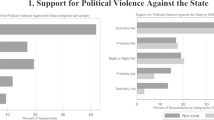Abstract
Are elections in autocracies a curse for incumbents? Using panel data from village elections in China, the OLS regression shows that introducing competitive elections has a relatively small effect on the removal of autocratic incumbents. However, the effect becomes much larger when the endogenous timing is instrumented with the passage of provincial election laws and village-specific election cycles. Additional evidence also suggests that removing incumbents through competitive elections enhances local governance. I interpret these results as suggesting that political selection matters in electoral autocracies.


Similar content being viewed by others
Notes
Each province (31 provinces in total) administrates about one hundred counties in rural areas as well as dozens of cities. There are hundreds of villages in each township. Village populations ranges in size from approximately 1,000 to 4,000.
Village levies included accumulating funds for financing public goods, public facilities, and administration costs. Township levies comprised fees for education and family planning plus support for militia training, road construction and military families.
Only in late 1991 did the central government stipulate that the total amount of village and town levies should not exceed 5 % of the net town income per capita in the previous year. (Source: Regulations on peasants’ burden and labor management. The State Council, 1991.) However, the implementation of this stipulation has been questionable.
For the first election held in the village, the question asks whether the elected chair belongs to the pre-election leadership.
This practice is more likely to be seen in large villages. Every 10 or 15 households select one representative, and the assembly of these representatives decide the candidates.
I also use the probit model to check the results. The results are largely consistent with those of the linear probability models.
One of the three committee members is an accountant.
Here this instrumental variable approach works like the encouragement design in a randomized controlled trial, where researchers randomly assign the subjects an encouragement to receive the treatment instead of randomizing over the treatment itself.
References
Alesina, A. (1988). Credibility and policy convergence in a two-party system with rational voters. American Economic Review, 78(4), 796–805.
Besley, T. (2005). Political selection. Journal of Economic Perspectives, 19(3), 43–60.
Besley, T., & Coate, S. (1997). An economic model of representative democracy. Quarterly Journal of Economics, 112(1), 85–114.
Besley, T., Pande, R., & Rao, B. (2005). Political selection and the quality of government: evidence from South India. Typescript.
Brandt, L., & Turner, M. A. (2007). The usefulness of imperfect elections: the case of village elections in rural China. Economics and Politics, 19(3), 453–480.
Chattopadhyay, R., & Duflo, E. (2004). Women as policy makers: evidence from an India-wide randomized policy experiment. Econometrica, 72(5), 1409–1444.
Choate, A. C. (1997). Local governance in China: an assessment of villagers’ committees. Working Paper, No. 1. San Francisco: Asia Foundation.
Diamond, L. (2002). Elections without democracy: thinking about hybrid regimes. Journal of Democracy, 13(2), 21–35.
Gan, L., Xu, L., & Yao, Y. (2005). Local governance, finance, and consumption smoothing. Memo. The World Bank Research Group.
Gan, L., Xu, L., & Yao, Y. (2006). Health shocks, village elections, and long-term income: evidence from rural China. NBER Working Paper w12686.
Gandhi, J., & Lust-Okar, E. (2009). Elections under authoritarianism. Annual Review of Political Science, 12, 403–422.
Geddes, B. (1996). The initiation of new democratic institutions in East Europe and Latin America. In A. Lijphart & C. Waisman (Eds.), Institutional Design in New Democracies. Boulder: Westview.
Guo, Z., & Bernstein, T. P. (2004). The impact of elections on the village structure of power: the relations between the village committees and the party branches. Journal of Contemporary China, 13(39), 257–275.
Iyer, L. (2010). Direct versus indirect colonial rule in India: long-term consequences. Review of Economics and Statistics, 92(4), 693–713.
Ministry of Civil Affairs (1998). 1997 civil affairs statistical report. http://www.mca.gov.cn.
O’Brien, K. J. (1994). Implementing political reform in China’s villages. The Australian Journal of Chinese Affairs, 32, 33–59.
O’Brien, K. J., & Li, L. (2000). Accommodating ‘democracy’ in a one-party-state: introducing village elections in China. China Quarterly, 162, 465–489.
Oi, J. C., & Rozelle, S. (2000). Elections and power: the locus of decision-making in Chinese villages. China Quarterly, 162, 513–539.
Osborne, M. J., & Slivinski, A. (1996). A model of political competition with citizen-candidates. Quarterly Journal of Economics, 111(1), 65–96.
Padovano, F. (2012). Are we witnessing a paradigm shift in the analysis of political competition? Public Choice. doi:10.1007/s11127-012-9920-5
Pande, R. (2003). Minority representation and policy choices: the significance of legislator identity. American Economic Review, 93(4), 1132–1151.
Powell, B. G. (2000). Elections as instruments of democracy: majoritarian and provisional visions. New Haven: Yale University Press.
Schedler, A. (2009). Electoral authoritarianism. In T. Landman & N. Robinson (Eds.), The SAGE handbook of comparative politics. London: Sage.
Shen, Y., & Yao, Y. (2008). Does grassroots democracy reduce income inequality in China? Journal of Public Economics, 92, 2182–2198.
Shi, T. (1999). Village committee elections in China: institutionalist tactics for democracy. World Politics, 51(3), 385–412.
Shi, T. (2000). Rural democracy in China. Cambridge/Singapore: Cambridge University Press/Singapore University Press.
Wang, S., & Yao, Y. (2007). Grassroots democracy and local governance: evidence from rural China. World Development, 35(10), 1635–1949.
Zhang, X., Fan, S., Zhang, L., & Huang, J. (2004). Local governance and public goods provision in rural China. Journal of Public Economics, 88(12), 2857–2871.
Acknowledgements
I am grateful to Michael Kremer, Rohini Pande, Erica Field for their advice and support. I have also benefited from comments by Gauri Kartini Shastry, Daniel Tortorice, Clement Kirabo Jackson, Elias Bruegmann, Katharine Emans Sims, Erin Strumpf, Quoc-Anh Do, Kai Guo, Tao Li, and participants of the Development lunch workshops at Harvard. All errors are mine.
Author information
Authors and Affiliations
Corresponding author
Appendix
Appendix
Rights and permissions
About this article
Cite this article
Han, L. Are elections in autocracies a curse for incumbents? Evidence from Chinese villages. Public Choice 158, 221–242 (2014). https://doi.org/10.1007/s11127-012-0004-3
Received:
Accepted:
Published:
Issue Date:
DOI: https://doi.org/10.1007/s11127-012-0004-3




